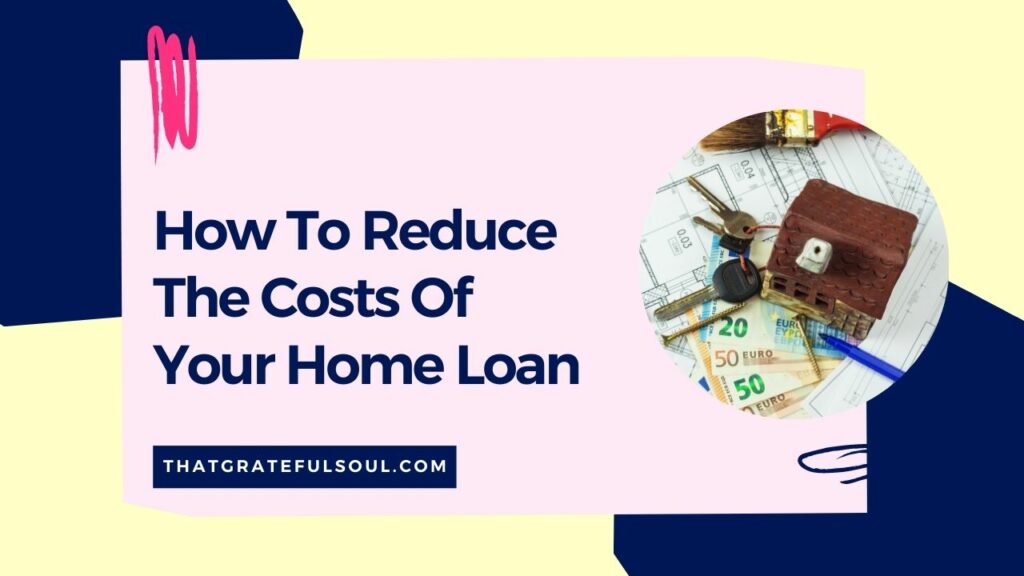Owning a home can often feel like an insurmountable mountain to climb, with costs that seem to keep rising.
However, just like climbing a mountain, there are many techniques available to help reduce the burden of your home loan.
Using strategies such as removing mortgage insurance or recasting your mortgage can be like scaling back down the mountain, leading you toward financial freedom.

-
Save
Table of Contents
How To Reduce The Costs Of Your Home Loan
In this article, we will explore a variety of methods for reducing the costs of your home loan.
Mortgage Insurance Removal
Through the removal of mortgage insurance, one may be able to lower their monthly home loan payments.
Mortgage insurance is an additional cost that can be avoided in certain cases and understanding the alternatives, calculating potential savings, and going through the cancellation process are important steps to reducing costs.
Here are some considerations for those looking to remove mortgage insurance:
- Mortgage Insurance Alternatives: It is beneficial to review all available options when it comes to mortgage insurance such as private mortgage insurance (PMI) or lender-paid mortgage insurance (LPMI). These alternatives may have different requirements for qualification and should be weighed against each other before making a decision.
- Calculating Mortgage Insurance Savings: Understanding how much you would save by removing mortgage insurance is key in determining whether or not it makes sense financially for you. This calculation requires factoring in associated fees with canceling your existing policy and setting up a new one if applicable.
- Mortgage Insurance Cancellation Process: Different lenders have different processes for canceling or removing mortgage insurance from your home loan depending on factors such as credit score, loan type, etc., so make sure you understand what needs to be done with your lender beforehand.
- Benefits of Mortgage Insurance Removal: The main benefit of removing PMI or LPMI from your home loan is saving money on monthly payments; however there are other benefits such as being allowed access to more equity in case of emergency situations as well as opening up opportunities like refinancing at a better rate later down the line.
- Mortgage Insurance vs Higher Down Payment: When deciding whether or not to opt into a higher down payment option versus paying for PMI or LPMI, you should consider which option will bring about more financial savings over time based on current interest rates and projected changes in the market.
Removing mortgage insurance can provide homeowners with significant cost savings depending on individual circumstances, but it is important to weigh all options carefully before taking any action toward this end goal.
By taking the time to refinance their home loan, borrowers may also experience further reductions in monthly payments due to lower interest rates and extended terms.
Refinancing
Refinancing a mortgage can provide an array of potential advantages, including the possibility of lower interest rates and extended loan terms.
The eligibility criteria for refinancing depends entirely on the borrower’s credit score and income along with other factors such as their debt-to-income ratio.
In order to refinance a home loan, borrowers must complete several steps which include applying for the loan, providing supporting documentation, undergoing a credit check, and appraisal of their current home value.
There are various types of refinancing options available that cater to different needs such as cash-out refinances or rate and term refinances.
Before considering any type of refinancing option, it is important to consider factors such as closing costs, length of time in residence, and existing loan balance.
Refinancing is not always the best option; however, if done correctly it can help reduce monthly payments or even shorten the repayment period.
Taking into account all these elements will help increase the chances of success when making decisions about refinancing a home loan.
Extending the Loan Term
Extending the loan term may provide borrowers with a lower monthly payment, and can potentially save them thousands of dollars over the course of the loan; for example, extending a 30-year loan to a 40-year loan can reduce the monthly payment by more than 10%.
The benefits of extending include reducing monthly payments and overall costs.
However, there are some risks associated with this practice as well.
For instance, if interest rates decrease significantly during this time period, borrowers may not be able to benefit from such an opportunity.
Additionally, borrowers must meet certain criteria in order to qualify for an extended term.
Alternatives to extending the loan term include refinancing or recasting a mortgage. Refinancing will result in closing costs that could affect overall savings while recasting involves making a lump sum payment to reduce principal balance without incurring additional fees.
Regardless of the option chosen, it is important for borrowers to consider how each one would impact their overall home loan cost before making a decision.
Switching to a Fixed Rate Mortgage
Switching from an adjustable-rate mortgage (ARM) to a fixed-rate mortgage (FRM) can provide borrowers with the stability of a consistent interest rate over the course of their loan.
This is one way for homeowners to reduce the costs associated with their home loans.
There are two main advantages that come with switching from an ARM to an FRM: lower interest rates and protection against rising interest rates in the future.
The pros of this option must be weighed against potential cons, such as qualification requirements, closing costs, prepayment penalties, and other fees.
Additionally, if prevailing market interest rates have decreased since taking out an ARM loan, refinancing into an FRM may not result in a substantial reduction in monthly payments or overall cost savings.
In conclusion, when considering whether to switch to a fixed-rate mortgage it is important for borrowers to carefully evaluate the pros and cons before making a decision.
The next option for reducing home loan costs is Streamline Refinancing.
Streamline Refinancing
Streamline Refinancing offers a simple and swift way to substantially reduce the financial burden of a mortgage, without sacrificing an ounce of convenience.
This type of refinance is ideal for those who are looking to lower their monthly payments while also avoiding the costly closing costs associated with traditional refinances.
Streamline Refinancing offers several benefits that make it worth considering:
- The eligibility requirements are less stringent compared to other refinancing options.
- There is no need for an appraisal, meaning the process is faster and simpler than other types of refinancing.
- Lenders typically only require basic loan documents, such as proof of income and credit score information, making them more accessible than traditional lenders. Potential savings vary based on individual circumstances but can be substantial if one qualifies for a lower rate or shorter term loan. It’s important to compare different lenders and rates when shopping around for Streamline Refinancing so you can find the best deal available in your area. With careful consideration and research, Streamline Refinancing could provide significant financial relief by lowering your monthly payments without sacrificing convenience or ease of access.
Recasting the Mortgage
Recasting a mortgage allows for an existing loan to be modified without having to go through the process of refinancing.
This is an attractive option for those who already have a low-interest rate but need to reduce their payments or change the terms of their loan, such as extending the length.
Recasting benefits include preserving one’s credit score, avoiding closing costs and other fees associated with refinancing, and potentially reducing the amount of money paid in interest over time.
To be eligible for recasting, borrowers must typically meet certain criteria such as having a good payment history and paying off at least 10-20% of the principal balance on their loan.
The recasting process involves submitting an application along with proof that funds are available to pay down part of the loan balance.
Once approved, lenders can adjust monthly payments and extend repayment terms accordingly.
It is important to note that there may be fees associated with recasting a mortgage which can vary depending on lender policies.
While similar in some ways, it is helpful to understand how recasting differs from refinancing before making decisions about which option would be best for one’s individual situation.
Forbearance Plans
Taking advantage of a forbearance plan can be a beneficial way to navigate difficult financial circumstances without having to resort to drastic measures such as switching, streamlining, or recasting one’s mortgage.
A forbearance plan is an agreement between the homeowner and the lender that allows for temporary relief from making regular monthly payments.
Generally, this type of arrangement is available in times of financial difficulty or when the homeowner has experienced a natural disaster.
When considering whether or not to apply for a forbearance plan it is important to consider eligibility requirements, payment deferral options, repayment options, potential credit impacts, and how best to communicate with your lender.
Forbearance plans are often structured differently depending on the individual situation of each borrower; however, typically they involve an agreed-upon period during which time no payments are required or payments may be reduced.
At the end of this period, homeowners will need to work with their lenders on repayment plans and/or loan modifications that would satisfy both parties involved in order to avoid foreclosure proceedings.
It is important for borrowers seeking forbearance relief to understand that while these arrangements can provide short-term solutions they should also prepare for long-term debt resolution by researching possible loan modification options.
Loan Modifications
A loan modification is an agreement between the lender and borrower that can provide a more permanent solution for homeowners facing financial difficulty.
It involves negotiating the terms of the loan such as amending the interest rate, principal amount, or repayment period to make it more affordable for borrowers.
To be eligible for a loan modification, a homeowner must meet certain requirements such as providing evidence of financial hardship and proof that they can afford the new repayment plan.
While it can have positive credit impacts in some cases, there are options available if there is a negative impact on credit scores after completing a loan modification.
Lenders also have several options when considering loan modifications including reducing the interest rate, extending the term of the mortgage, or forbearing payments temporarily until circumstances improve.
Ultimately, loan modifications are meant to offer long-term solutions with sustainable repayment plans that fit within a borrower’s budget so they can remain in their home.
Conclusion
In conclusion, reducing the costs of your home loan can be a daunting task but it is possible to make progress.
There are various strategies you can employ to reduce the burden of your loan, such as mortgage insurance removal, refinancing, extending the loan term, and switching to a fixed-rate mortgage.
Streamline refinancing and recasting the mortgage can also provide relief from high-interest rates.
Finally, forbearance plans and loan modifications offer additional options for those facing financial difficulties.
By taking advantage of these opportunities, homeowners can leverage their resources in order to achieve long-term savings on their home loans.
Like pieces in a puzzle coming together, each strategy works to create an overall picture of success and financial stability.
-
Save

